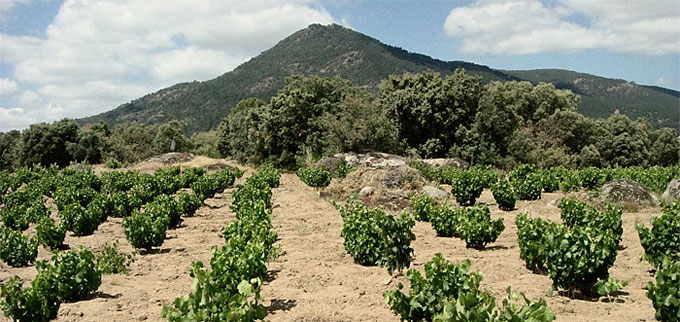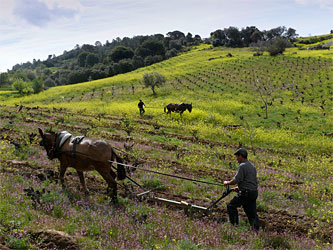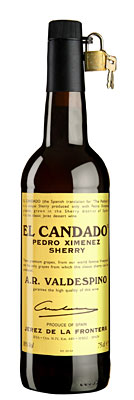| February 2015 | ||
| « Dec 2014 | News | Mar 2015 » |
February 24, 2015
The Bear's Forest: Synonymous with Grand Garnacha
San Martín de Valdeiglesias lies a mere 75 minutes from Madrid in the Madrid highlands. As one drives west from the capital city, the terrain quickly becomes rugged and mountainous, the air cooler, and one begins to see signs of an earlier era. San Martín is one of three subzones of the Viños de Madrid DO (created in 1990). The DO is sandwiched between La Mancha and the Spanish capital, where it forms a semicircle around the southern suburbs of Madrid. While much of the wine produced within the Viños de Madrid DO is comparable to the mass production of La Mancha, within San Martín and the other two sub-zones (Navalcarnero, Arganda) there grows in strength a small group of dedicated, quality-conscious producers that are slowly building a name for themselves. Bernabeleva is one of them.

Bernabeleva resides in the small village of Pelayos de la Presa, next to San Martín de Valdeiglesias, a historic town after which the sub-appellation takes its name. The producers in this small zone are careful to include “San Martin de Valdeiglesias” on their labels, to indicate and differentiate the higher level of quality found here. Bernabeleva (“the bear’s forest”) is named for its Celtic past, which is seen in the landscape with ancient bears carved from boulders to mark forests dedicated to the hunt goddess.
Bought and named in 1923 by renowned Madrid doctor named Vincente Alvarez-Villamil, it wasn’t until 2006 that the dream of producing wine on the estate became realized. In 2006, Vincente’s great-grandchildren Juan Diez Bulnes and Santiago Matallana Bulnes took over the estate’s 80-year old vineyards and resolved to make wines of purity and expressiveness that were in harmony with the beauty of their ancestral land. The cousins wanted, above all, to protect the unique personality of their estate, and they hired consultant Raúl Pérez, a master of cool-climate winemaking, to help them develop the project. Raúl is no longer apart of the project.
 Just as important, they hired as full-time manager and winemaker, a young Catalan named Marc Isart Pinos. Marc’s devotion to demanding viticulture and to non-interventionist winemaking has served the cousins’ vision well. He is passionately focused on transforming the project to 100% biodynamics. In addition to the deep, perfumed and incredibly mineral Garnacha-based red wines they produce, there is also the Blanco de Bernabeleva 2012 (60% Albillo and the rest Macabeo), which is available for pre-order!
Just as important, they hired as full-time manager and winemaker, a young Catalan named Marc Isart Pinos. Marc’s devotion to demanding viticulture and to non-interventionist winemaking has served the cousins’ vision well. He is passionately focused on transforming the project to 100% biodynamics. In addition to the deep, perfumed and incredibly mineral Garnacha-based red wines they produce, there is also the Blanco de Bernabeleva 2012 (60% Albillo and the rest Macabeo), which is available for pre-order!
José Luis Mateo, owner of Quinta da Muradella, summed it up best when he said, “Of all the producers around Madrid, for me he is the best. His wines have the most finesse.”
February 11, 2015
Think Outside the Box [of Chocolates] by Erin Drain
It’s about to be Valentine’s Day again in a couple days, and as you rush to find small tokens of love and affection at the eleventh hour, one perennial standby is chocolate. Sweets for the sweetheart, although a little bit of a softball, are regardless almost universally loved. (But will never make up for forgetting to reserve a romantic table for two at your favorite restaurant, so hop to it if you still haven’t done so, and godspeed!)
Popular romantic lore dictates that the aforementioned emergency chocolates should be slowly consumed with a bottle of red wine, ideally in front of a fireplace somewhere like Door County or, better, Vail. But let’s face it: for many of us, Valentine’s Day is a working holiday, and what’s worse, the marriage of dry red wine and chocolate is actually rather dismal territory. While not a capital offense, it’s nonetheless pretty unpleasant to distract the palate from a perfectly good Pomerol by out-sweeting it with bonbons. Likewise, best keep the dusty, drying tannin of Barolo far away from a pricy bar of Vosges. There are far better matches for chocolate, and more creative ideas, at that. Don’t fight with your truffles this Valentine’s Day: get on trend and break out a bottle of sherry.
 Not just any sherry, though! The man for the job is our good friend, Pedro Ximenez. PX, as he’s otherwise known, is a light-skinned, neutral grape that’s not terribly exciting on its own, but for this is the perfect blank slate for D.O. Jerez’s wondrous gift: the transformative power of terroir, time, and oxygen. The ‘El Candado’ bottling from grand dame sherry house Valdespino averages ten to twelve years in barrel, oxidizing slowly after being pressed from grapes dried to raisins in the intense Andalusian sun. And while this is a rather sweet wine at nearly 500 grams/liter of residual sugar, the freshness imparted from Jerez’s chalky albariza soils and its extended aging keep the wine nuanced, showing chocolate, figs and nut flavors, but also a slightly savory and smoky finish. A candado in Spanish is a padlock; this historical wine was so beloved and special, it was - and still is- kept under lock and key.
Not just any sherry, though! The man for the job is our good friend, Pedro Ximenez. PX, as he’s otherwise known, is a light-skinned, neutral grape that’s not terribly exciting on its own, but for this is the perfect blank slate for D.O. Jerez’s wondrous gift: the transformative power of terroir, time, and oxygen. The ‘El Candado’ bottling from grand dame sherry house Valdespino averages ten to twelve years in barrel, oxidizing slowly after being pressed from grapes dried to raisins in the intense Andalusian sun. And while this is a rather sweet wine at nearly 500 grams/liter of residual sugar, the freshness imparted from Jerez’s chalky albariza soils and its extended aging keep the wine nuanced, showing chocolate, figs and nut flavors, but also a slightly savory and smoky finish. A candado in Spanish is a padlock; this historical wine was so beloved and special, it was - and still is- kept under lock and key.
February 10, 2015
FEATURED: Jura: The Next Small Thing
As the smallest appellation in France with an entirely idiosyncratic way of making wine, Jura has serious indie cred. Thanks to isolation afforded by the wooded, rolling Jura Mountains, this region between Burgundy and Switzerland has developed a unique style that you won’t find replicated anywhere. The wines are quirky, food-friendly—and really, really good. Some Jura winemakers have taken steps toward making more readily recognizable table wines, but truly, its deeply rooted traditional style is what has put it on the map: oxidated, nutty whites; meaty, light-bodied reds with grip; and an array of dessert wines—all from mostly native grapes.
